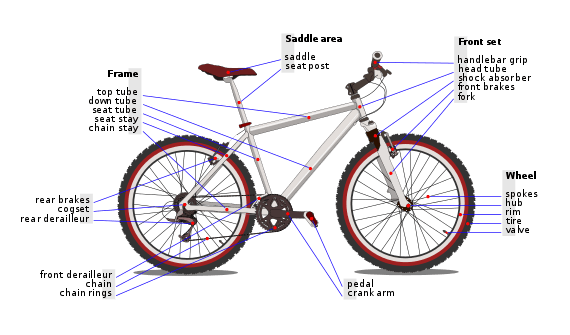Bicycle tools
Various bicycle tools have evolved over the years into specialized tools for working on a bicycle. Modern bicycle shops will stock a large number of tools for working on different bicycle parts. This work can be performed by a trained bicycle mechanic, or for simple tasks, by the bicycle owner.
Various tools by function
Hub, wheel and tire tools
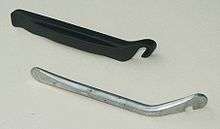

- Tire levers are used for removing the tires from the rim, often for changing the inner tube. Plastic levers are more prone to breakage; metal ones damage tubes, tires, or rims more easily.
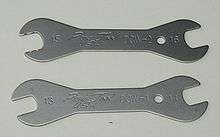
- Cone wrenches (spanners) are needed to dismantle and adjust the hub bearings.
- Spoke wrenches are used for tensioning the spokes of a wheel.
- Tensiometer or spoke tension meter is used to measure the tension in spokes.
- Tire bead jack can be used to install tires on rims, especially when the tire-rim combination is tight.
- Dishing gauge is used to measure the dish of a wheel.
- Wheel truing stand is used to measure the side to side and radial trueness of a wheel's rim and facilitate truing it.
- Bicycle pump
Brake tools
- Cable and housing cutters
- Cable tensioning tool to hold the cables taut while being worked on.
- Third hand or 3rd hand to clamp brake pads against rim during adjustment.
- Rotor truing tool
Headset tools
- A head tube facing and reaming tool is a hand tool used to machine the head tube to ensure proper headset bearing alignment. The tool usually has separate and interchangeable facing and reaming cutters which can vary widely with the many available headset standards.
- A headset bearing cup press is a bearing press specifically for pressing in interference-fit headset cups. Most sets come with special stepped bushings or adapters that contact the cups, preventing damage when installed. Some manufacturers (e.g. Chris King) also make proprietary adapters for installing their headsets.
- A crown race cutting tool is a hand tool used to counter-ream and face the base of the fork column at the crown (known as the crown race seat). A single cutter is usually used to perform both aspects of the cutting operation. The process machines the crown race seat to be precisely perpendicular to the steering column axis and of the correct press-fit diameter, ensuring the proper alignment of the crown race with the lower headset bearing.
- A crown race puller or remover is a tool for removing the headset crown race. There are various tools on the market ranging from less than US$100 to several hundreds of dollars.
- Headset wrenches are oversized (32 – 36 mm) flat open-end wrenches for tightening headset cups and lock nuts on threaded steering tubes. May be designed to contact 7 sides of an 8 sided (8-point) lock nut.
- Hex (or Allen) keys are used on the various hex bolts on the stem, top cap and handlebars.
- A star-nut setter is used to set the star-nut inside of the fork steering column for threadless headsets.
Drivetrain and bottom bracket tools
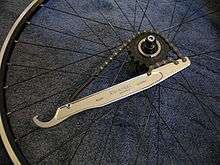
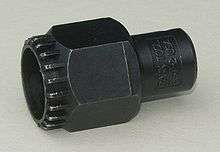
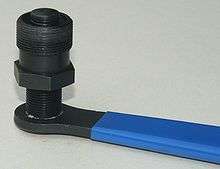
- A chain tool or chain splitter is used to 'break' a chain, in order to remove it from a bike or remove links, or to put a chain back together.
- A crank extractor is used to pull the crank off the bottom bracket spindle.
- A pedal wrench removes the pedals from the bicycle.
- A pin spanner is used on adjustable bottom brackets. Note that ISIS Drive bottom brackets need a separate tool (see below).
- Various bottom bracket wrenches for newer bottom bracket styles such as internally splined by ISIS, Shimano, FSA, and RaceFace; externally notched by Campagnolo Veloce, Xenon, Mirage, Daytona and Avanti; and externally mounted by Shimano.
- Bottom bracket taps and facing tools are tools used to tap or chase the threads in the bottom bracket shell and face the outside edges, respectively. A single tool will sometimes handle both jobs, and is usually suitable for light-duty bicycle shop use. A separate tap set and facing set is usually employed by frame builders where more robust tooling that is more frequently used is needed. Both tap sets and facing sets are intended for frame finishing work after welding and/or brazing, as the frame tubes tend to deform slightly after this process, and for cleaning out any weld splatter or paint from the bottom bracket threads. A bottom bracket tap set can be used to tap new threads in a blank bottom bracket shell (or for converting ISO threads to larger diameter Italian), but the process is slow and cumbersome and especially hard on most taps, particularly when tapping hard aluminum or titanium.
- A chain whip and lock-ring remover are used for changing derailleur cassettes.
- Various freewheel removers are used to unscrew freewheels from hubs.
- A derailleur alignment gauge is used to straighten rear derailleur hangers.
Stands
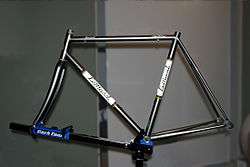
Various devices have been devised to hold a bike still to facilitate working on it, and they are usually called stands. Stands may clamp a part of the bike, such as the seatpost, seat tube, or top tube, or they may simply provide a surface on which a bike may rest with some security. Stands, especially those that clamp to a bike, may provide a means of repositioning a bike in order to conveniently locate the part being worked on. Stands may be either portable (light and collapsible) or fixed (heavy, usually attached to the floor, wall, or bench).
Care must be taken with clamping stands not to clamp a part of the bike that cannot withstand the pressure, such as the tubes of many aluminum or carbon fiber frames, and non-cylindrical carbon fiber seatposts. An auxiliary bracket may be used with clamping stands to keep the steering mechanism from rotating.
See also
| Wikimedia Commons has media related to Bicycle tools. |
